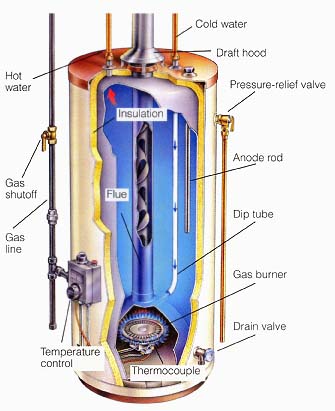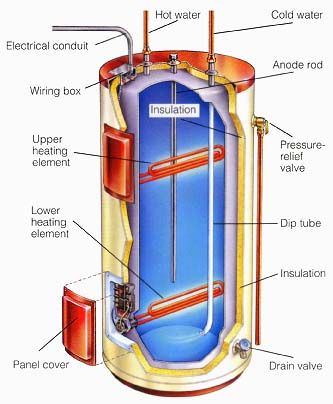|
Normally, a water heater is so reliable and maintenance free, you can practically ignore it. On average, it takes about 13 years for one to go bad, but with faithful maintenance, it can last indefinitely. Rust is the terminal disease for a water heater. Once it eats through the steel tank and causes it to leak, you have to replace the unit. Although the tank’s inside surface has a glass coating baked onto it, this coating eventually cracks and rust begins. Failure typically begins around the tank-pipe joints, at the welds or on the bottom where sediment collects. Heavy sedimentation from the minerals in the water, especially hard water, causes sediment to pile up on the bottom and trap heat from a gas burner, raising the temperature on the bottom higher than normal and stressing the steel tank and glass coating. On gas units, you can detect this problem by a rumbling or popping sound that occurs soon after the burner comes on. The best defense against sediment buildup is to annually drain the tank through the drain valve and flush it according to the directions in your owner’s manual. Unfortunately, many manufacturers use cheap drain valves, so plan to replace it with a more reliable ball-type valve during the first cleaning. Besides the glass coating, your water heater’s other defense against rust is a special rod called a sacrificial anode (see illustrations) made of magnesium or some times aluminum. The anode helps stop the chemical reaction that causes the steel tank to rust. In the process, the anode itself corrodes, or sacrifices, itself. Anodes typically last five years or longer, and some heaters have two to prolong the water heater’s life. Replacing them generally requires a professional. |
|


How they work
In most water heaters, cold water enters the bottom of the storage tank through a dip tube, where the water is heated to about 120°F to 140°F (50°C to 60°C) until there’s a demand for it. Hot water then exits the tank at the top, pushed out by the pressure of incoming cold water. On the cold side inlet, the valve is open so there’s always water pressure in the tank. Since hot water is more buoyant than cold, it rises to the top and remains somewhat separate until the cold is heated. A thermostat near the bottom senses when cold water arrives and automatically switches on the heating device.|
Gas heaters must be vented through a flue or a power vent. The base of this vent’s draft hood is an excellent place to check for back-drafting problems. Because gas heaters heat water more quickly than electric models, they tend to be smaller. The most common problem with a gas heater is a failed thermocouple. Components of a Gas Water Heater: Cold water; Draft hood; Pressure-relief valve; Anode rod; Dip tube; Gas burner; Drain valve; Hot Water; Gas Shutoff; Gas Line |
 |
|
Electric heaters use one, or more often two, heating elements. If an electric heater has two elements, the upper element acts as a supple mental heater that only operates during heavy demand; consequently, it rarely fails. Electric heaters take longer to heat the water tend to be larger and cost more to operate. However, not requiring a venting system makes them significantly easier to install. Components of an Electric Water Heater: Electrical conduit; Hot water; Cold water; Anode rod; Pressure-relief
valve; Dip tube; Insulation; Drain valve; Electrical conduit; Wiring
box; Upper
heating
element; Lower
heating
element; Panel cover; |
 |
Links:
Consumer Guide to Home Energy Savings: Condensed Online Version
